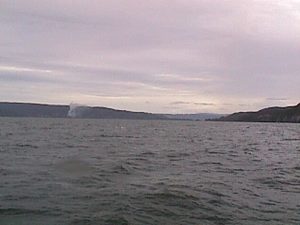
“Looking east from a mile out to sea, it was easy to see land, but hard to distinguish the Bay of Corral. The hills surrounding it, plus the islands in the center of the bay acting like a backdrop, looked continuous, and were it not for the small towns on either side, Corral to the south, Niebla to the north, it would have been hard to tell there was an entrance there at all.
Arturo wondered how they found the bay in the old days in the first place, when there were no towns at all, or for that matter, at night, with no lights, or on foggy days, regardless of lights. He guessed that back when, many ships probably “laid to,” waiting for daylight to arrive, or the fog to clear, and since they were sailing ships, for the wind to cooperate. It was the only safe way he could imagine to enter the bay. Miss it by a few yards, and there was nothing but a craggy coastline waiting for the stray boat, with hidden rocks close to shore, usually not advertising their presence at all, but near to the surface, skulking; slow, patient, deliberate rocks, surrounded by angry looking foam and froth of the near coastline, hell-bent and determined to open up any hull, be it wood or metal, like a ripe watermelon dropped on a sidewalk, emptying its innards, spilling men, like black seeds into the cold water, cargo all over the sea floor. Lot of history out there, thought Arturo, lots of close calls, lots of disasters, I’m sure. On a windy day, the waves were serious enough to sober any sailor, the waves during a storm, especially if the storm originated out in the middle of the Pacific, enough to make experienced seadogs think twice, then turn to drink, get wobbly kneed, and nobody to blame them. The name Niebla, the town on the north side, meant fog in Spanish. “Enough said,” muttered Arturo, mostly to himself, as he looked out towards terra firma, dry land, convinced his reasoning was watertight.”
From Julio, book 5 in the Cuco series.

